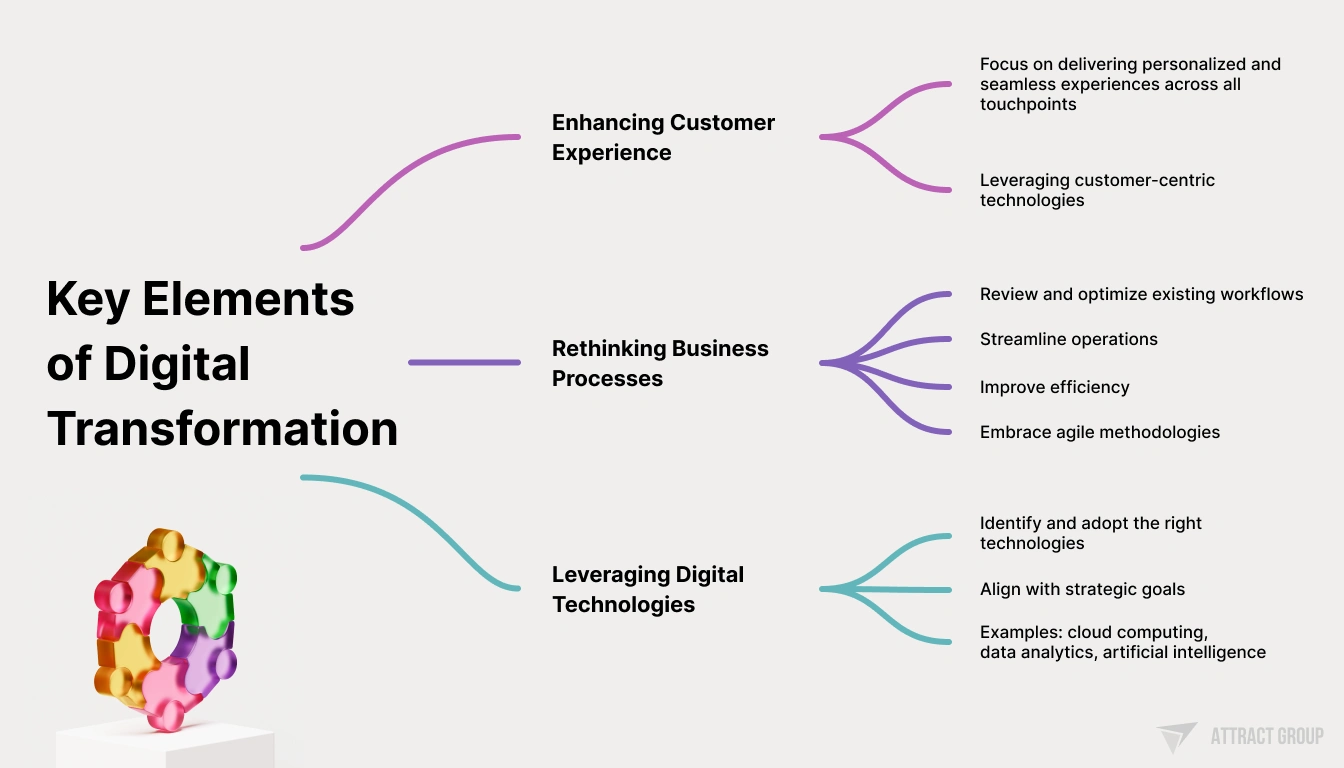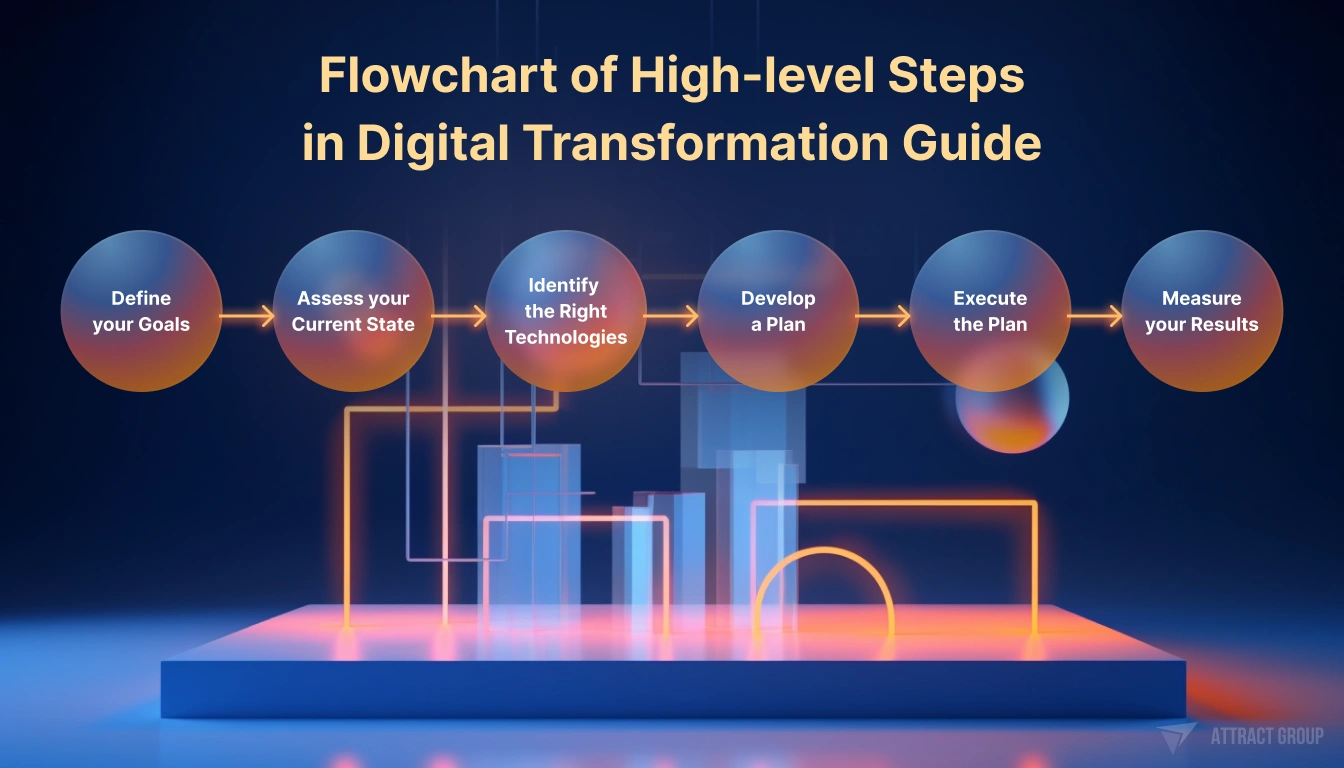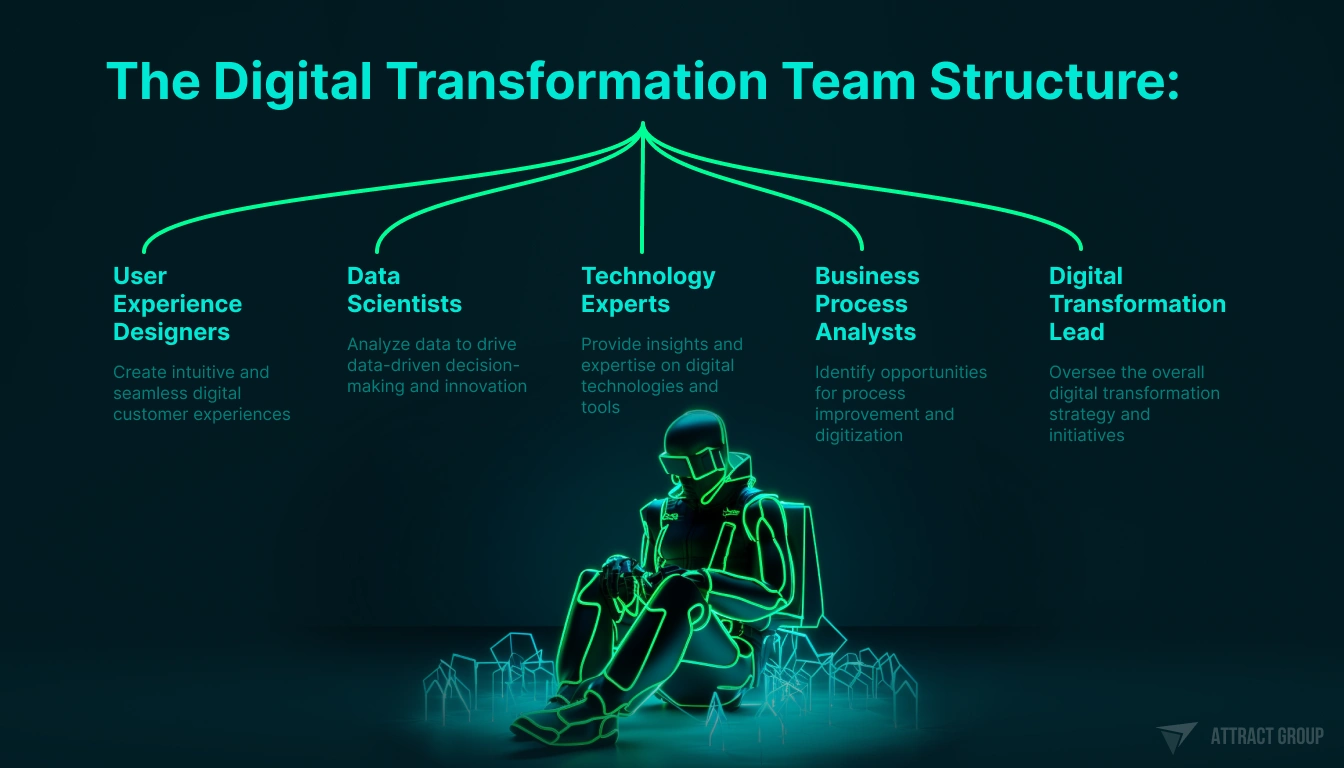Digital Transformation Basics: Transforming Traditional Businesses
 15 September 2023
15 September 2023? Listen to the Summary of this article in Audio
Digital transformation is the process of integrating digital technologies into traditional businesses, revolutionizing business processes, and reshaping how organizations operate. It involves rethinking business models, changing technology infrastructure, innovating customer experience, and reshaping company culture. This transformative journey is vital for businesses to remain competitive and meet the demands of modern consumers:
- Digital transformation involves integrating digital technologies into traditional businesses.
- This process revolutionizes business processes, reshaping how organizations operate.
- Rethinking business models and leveraging digital technologies are crucial for modern company success.
- Organizations need to challenge the status quo, experiment, and embrace failure to drive digital transformation initiatives.
“When digital transformation is done right, it’s like a caterpillar turning into a butterfly, but when done wrong, all you have is a really fast caterpillar.” (source)
George Westerman, MIT Sloan Initiative on the Digital Economy
Here are some fascinating statistics about digital transformation that should inspire you:
- The global digital transformation market is set to skyrocket to a staggering $1,010 billion by 2025. Digitally transformed organizations are predicted to contribute over half of the world’s gross domestic product (GDP) by 2023, amounting to a remarkable $53.3 trillion (source).
- Astonishingly, 70% of digital transformations end up failing, often due to employee resistance (source).
- Companies that prioritize digital-first strategies are a remarkable 64% more likely to achieve their business goals compared to their competitors (source).
- The market size for digital transformation reached in 2022 an impressive $731.13 billion, and it’s projected to keep growing at an astonishing compound annual growth rate (CAGR) of 26.7% until 2030 (source).
These eye-opening statistics underscore the increasing significance of digital transformation, its profound impact on the global economy, and the obstacles that businesses must overcome in the process. Let these numbers motivate you in the journey of Digital Transformation!
Contact us, and we’ll develop a custom solution for your business!
The Meaning of Digital Transformation
Digital transformation refers to the strategic use of new technologies to fundamentally transform a business, enabling it to adapt and thrive in the digital age. It goes beyond simply adopting new technologies; it requires a comprehensive business strategy that aligns with the digital era. In today’s rapidly evolving digital landscape, organizations must embrace digital transformation to remain competitive and meet the demands of modern consumers.
Cloud computing, the Internet of Things (IoT), big data, and artificial intelligence (AI) are key areas driving digital transformation. These technologies offer immense potential for businesses to improve efficiency, enhance customer experience, and unlock new revenue streams. By leveraging these technologies, organizations can optimize their operations, streamline business processes, and gain deep insights into customer behavior.
However, digital transformation is not just about technology; it also requires organizational change. Companies need to challenge the status quo, experiment with new ideas, and foster a culture of innovation and agility. This may involve breaking down traditional silos and implementing cross-functional collaboration. Leaders play a critical role in driving digital transformation initiatives, setting a clear vision, and providing the necessary resources and support.
To ensure successful digital transformation, organizations must develop a clear strategy and roadmap, taking into account their unique business goals and challenges. They need to break down barriers to change, engage employees at all levels, and cultivate a partner ecosystem to leverage external expertise and resources. Digital transformation should be seen as an investment rather than a cost, with a focus on long-term value creation and sustainable growth.
Key Elements of Digital Transformation
Successful digital transformation efforts involve enhancing customer experience, rethinking business processes, and leveraging digital technologies to drive business value. These key elements are essential for organizations looking to adapt and thrive in the digital age.

To start, enhancing customer experience is crucial in today’s competitive landscape. Organizations must focus on understanding customer needs and preferences to deliver personalized and seamless experiences across all touchpoints. This can involve implementing customer-centric technologies like chatbots, AI-powered recommendation engines, and self-service portals to provide convenient and efficient interactions.
Additionally, rethinking business processes is vital for successful digital transformation. Organizations need to review and optimize their existing workflows to streamline operations, improve efficiency, and reduce costs. This can be achieved by automating manual tasks, implementing workflow management systems, and embracing agile methodologies to enable faster iteration and adaptation.
“The next 5 years will be more disruptive than the last 15. This is NOT business as usual. A lot of technology that came in three years ago doesn’t work anymore.” (source)
Saul Berman, IBM
Leveraging digital technologies is the third key element of digital transformation. Organizations need to identify and adopt the right technologies that align with their strategic goals. This can include implementing cloud computing solutions for scalability and flexibility, utilizing data analytics platforms for actionable insights, and embracing artificial intelligence and machine learning to drive intelligent automation and decision-making.
By focusing on these key elements, organizations can unlock the full potential of digital transformation and drive business value. It is important to have a clear vision, strategic roadmap, and strong leadership to navigate the complexities of digital transformation and achieve sustainable success in the digital era.
Key Elements of Digital Transformation:

To simplify this chart, there’re 3 main elements of DT:
| Element | Description |
|---|---|
| Enhancing Customer Experience | Focus on delivering personalized and seamless experiences across all touchpoints, leveraging customer-centric technologies. |
| Rethinking Business Processes | Review and optimize existing workflows to streamline operations, improve efficiency, and embrace agile methodologies. |
| Leveraging Digital Technologies | Identify and adopt the right technologies that align with strategic goals, such as cloud computing, data analytics, and artificial intelligence. |
Successful digital transformation requires a holistic approach that considers the interplay between customer experience, business processes, and digital technologies. Organizations that prioritize these key elements will be well-equipped to navigate the evolving digital landscape and stay ahead of the competition.
Benefits and Business Value of Digital Transformation
There are many benefits to digital transformation for traditional businesses. These benefits include:
1. Increased efficiency:
Digital technologies can help businesses to streamline their operations and become more efficient. For example, a business can use digital tools to automate tasks, track inventory, and manage customer relationships.
By automating processes, eliminating manual tasks, and implementing digital solutions, businesses can streamline operations, reduce errors, and improve overall efficiency. This allows employees to focus on more strategic activities, leading to higher productivity and cost savings.
2. Revenue growth:
Another important business value of digital transformation is revenue growth. By leveraging digital technologies, organizations can reach a wider audience, expand their market reach, and explore new business models. For example, the adoption of e-commerce platforms can enable businesses to sell their products or services online, reaching customers globally and driving revenue growth.
3. Improved customer experience:
Digital technologies can help businesses to provide a better customer experience. For example, a business can use a website or mobile app to allow customers to order products or services online, track their orders, and get customer support.
Additionally, digital transformation plays a crucial role in improving customer satisfaction. By leveraging data analytics and customer insights, businesses can personalize their offerings, tailor experiences, and deliver personalized solutions. This enhances customer satisfaction, builds brand loyalty, and improves overall customer experience.
4. New opportunities:
Digital technologies can open up new opportunities for businesses. For example, businesses can use social media to reach new customers or big data analytics to identify new market trends.
Digital Transformation is a way for businesses to make really big changes. It’s not just about using fancy computers; it’s about changing everything to be more modern and better. Here’s what it means:
- Big Changes: We’re not talking about small fixes. It’s like a caterpillar turning into a butterfly – a total transformation.
- Fast Changes: Technology keeps moving quickly, so businesses must keep up. Digital Transformation says we should always be making things better.
- Everything Changes: It’s about what you do and how you do it. Think of it as a big upgrade for your business.
- Using Technology: This is the heart of it. It’s about using things like smart computers, the internet, and data to improve your business.
What To Remember?
- Not Just About Computers: Digital Transformation is more than just using computers. It’s about changing the way you do business for the better.
- You Can’t Skip It: In today’s fast world, Digital Transformation isn’t a choice; you have to do it to stay in the game.
- Customers Come First: One important thing is making your customers happy. Digital Transformation is about giving them the best experience. Understanding Digital Transformation is like having a map before a big journey.
In conclusion, digital transformation has become essential for businesses to remain competitive and meet the demands of modern consumers. By embracing digital technologies, businesses can unlock numerous benefits, including increased operational efficiency, revenue growth, improved customer satisfaction, and the ability to drive innovation. Organizations that fail to adapt to the digital age risk falling behind their competitors and missing out on valuable opportunities for growth and success.
High-Level Guide To Digital Transformation
Digital transformation is a journey that can revitalize your business, but it requires careful planning and execution. To help you navigate this transformative process, we’ve outlined a step-by-step guide:

Step 1: Define Your Goals
The first crucial step in digital transformation is defining clear goals. Ask yourself, what do you want to achieve through this transformation? Do you aim to:
- Improve Operational Efficiency?
- Increase Sales and Revenue?
- Reach New Customers and Markets?
- Enhance Customer Experiences?
- Streamline Processes and Reduce Costs?
By articulating your objectives, you create a roadmap for your transformation journey. Having well-defined goals will keep your efforts focused and measurable.
Step 2: Assess Your Current State
Before embarking on digital transformation, you must understand where your business stands. Conduct a thorough assessment:
- Identify your strengths and weaknesses.
- Analyze your existing technologies and infrastructure.
- Evaluate your workforce’s digital skills and readiness.
- Recognize opportunities for growth and potential challenges.
This assessment sets the baseline against which you’ll measure progress throughout your transformation.
Step 3: Identify The Right Technologies
Many technologies are available for digital transformation, from data analytics and artificial intelligence to cloud computing and IoT. To choose the right ones for your business:
- Consider your goals and challenges.
- Evaluate your budget and resource constraints.
- Assess the scalability and compatibility of technologies.
- Explore industry-specific tools and solutions.
Select technologies that align with your objectives and will deliver the most significant impact.
Step 4: Develop A Plan

Creating a well-defined digital transformation plan is critical. Outline:
- Specific tasks and milestones.
- Responsibilities and roles within your organization.
- Timelines and deadlines for implementation.
- Key performance indicators (KPIs) to measure success.
- Contingency plans for unexpected challenges.
A comprehensive plan ensures everyone is on the same page and provides a roadmap for the transformation process.
Step 5: Execute The Plan
This is where the rubber meets the road. Start implementing your digital transformation plan according to your timeline. Ensure that your teams have the necessary training and resources. Monitor progress closely, and be prepared to make adjustments as needed to stay on track.
Step 6: Measure Your Results
Regularly measure your progress once you’ve begun implementing your digital transformation initiatives. Use the KPIs you defined earlier to evaluate whether you’re meeting your goals. Adjust your strategies and tactics based on the data and insights you gather.

Remember that digital transformation is an ongoing process. Your organization must remain adaptable and open to change as technology and business worlds evolve. Periodically revisit your goals, reevaluate your technologies, and refine your strategies to stay ahead in the digital age.
By following this short guide, you can confidently navigate the complex journey of digital transformation and make strategic decisions that will help your business thrive in the digital era.
Contact us today to get started!
The Role of Leadership in Digital Transformation
Business leaders play a pivotal role in the success of digital transformation projects, with the establishment of a dedicated digital transformation team and the appointment of a Chief Digital Officer being key factors for success. Digital transformation requires a top-down approach, with leaders championing the adoption of digital technologies and driving a culture of innovation and agility within the organization.
A dedicated digital transformation team is essential for overseeing and coordinating the various initiatives involved in the transformation process. This team should consist of experts from different departments who can collaborate and share their knowledge and experiences. By having a dedicated team, organizations can ensure that digital transformation efforts are prioritized, effectively managed, and aligned with strategic goals.
The appointment of a chief digital officer (CDO) is another crucial step in driving digital transformation. The CDO is responsible for leading the digital strategy, overseeing the implementation of digital initiatives, and ensuring that the organization stays ahead in the rapidly evolving digital landscape. The CDO acts as a bridge between the business and technology departments, ensuring that digital transformation is integrated seamlessly into all aspects of the organization.
The Digital Transformation Team Structure:
| Role | Responsibilities |
|---|---|
| Digital Transformation Lead | Oversee the overall digital transformation strategy and initiatives, ensuring alignment with new digital paradigms. By analyzing examples of digital transformation from various sectors, they can pinpoint successful strategies and avoid pitfalls. Staying updated with digital transformation trends is crucial to the role, as it helps in shaping the organization’s digital transformation roadmap. |
| Business Process Analysts | Identify opportunities for process improvement and digitization by assessing current workflows. They delve into examples of digital transformation to understand best practices and pitfalls. With the rise of new digital methodologies, these analysts play a pivotal role in ensuring that the organization’s digital transformation aligns with the latest industry standards. |
| Technology Experts | Provide insights and expertise on digital technologies and tools, ensuring that the organization leverages the best solutions. Many digital transformations fail due to the incorrect choice of technology; hence, their expertise is invaluable. By continuously updating their knowledge and using digital technologies effectively, they ensure the success and sustainability of digital initiatives. |
| Data Scientists | Analyze vast amounts of data to drive data-driven decision-making and innovation, which is central to any organization’s digital transformation. By studying patterns, anomalies, and insights from the data, they can suggest strategies that align with digital transformation trends. Their role is not just limited to analysis; it’s about ensuring that digital transformation’s objectives are met through actionable insights. |
| User Experience Designers | Create intuitive and seamless digital customer experiences by understanding user behaviors and preferences. Given that a significant number of digital transformations fail due to poor user adoption, their role is of paramount importance. Incorporating feedback and using digital technologies to refine interfaces, they ensure that the user experience aligns with the organization’s digital transformation goals. |

Having strong support from business leaders is crucial for overcoming resistance to change and driving digital transformation initiatives. Leaders need to communicate the vision and benefits of digital transformation to the entire organization, ensuring that everyone understands the importance of embracing digital technologies and adapting to the digital age.
By establishing a dedicated digital transformation team and appointing a chief digital officer, organizations can navigate the complexities of digital transformation more effectively. This leadership-driven approach sets the foundation for successful digital transformation, enabling businesses to evolve, remain competitive, and meet the demands of the modern digital landscape.
Digital Transformation Strategies Samples
| Key Strategies | Benefits |
|---|---|
| Develop a clear transformation strategy | – Alignment with organizational goals – Enhanced operational efficiency – Competitive advantage |
| Create a roadmap for the digital transformation journey | – Clear guidance and direction – Minimized disruption – Timely implementation |
| Foster a culture of innovation and agility | – Increased employee engagement – Improved creativity and problem-solving – Accelerated time to market |
A successful transformation starts with a clear strategy, informed by examples and best practices. Here, we present a few digital transformation strategies, peppered with real-world digital transformation examples that can guide businesses through this journey.
1. Embrace Digital Innovations: At the core of any transformation is the embracement of digital innovations. Companies like Netflix and Uber are prime digital transformation examples. They disrupted traditional industries by leveraging new technologies, epitomizing the definition of digital transformation.
2. Go Paperless with Digital Records: Switching to digital records not only reduces the carbon footprint but also improves efficiency. Hospitals adopting electronic health records (EHR) stand as a testament to the advantages of digitizing manual processes.
3. Anticipate Digital Disruption: In the age of rapid innovation, digital disruption is inevitable. Blockbuster’s downfall with the rise of streaming services is a cautionary tale. Businesses should always be on the lookout for the next game-changing technology in their industry.
Table: Key Areas of Investment for Digital Transformation:
| Area | Importance |
|---|---|
| Digital Talent | Hiring the right digital talent ensures that you have the expertise to drive transformation. |
| Technological Infrastructure | Heavy digital transformation investments in infrastructure lay the foundation for future initiatives. |
| Training and Development | Investing in upskilling the workforce is crucial to address digital transformation challenges. |
4. Measure Digital Transformation ROI: Every business move should have measurable outcomes. Assessing digital transformation ROI ensures that businesses get value from their efforts. Using metrics like customer satisfaction, operational efficiency, and revenue growth can help in quantifying success in digital endeavors.
5. Stay Updated with Trends: With the ever-evolving technological landscape, staying updated with the latest trends in digital transformation is imperative. Adopting augmented reality in retail or AI in customer service are just a few instances that showcase the importance of keeping a pulse on industry trends.

6. Prioritize Customer Experience: Any part of digital transformation should have the customer at its heart. The process of using digital technologies should aim to enhance the customer journey, making it seamless and intuitive.
To define digital transformation succinctly, it’s not just about technology. The transformation is better thought of as a holistic approach that encompasses strategy, customer experience, and operational efficiency. Utilizing digital data effectively, making informed decisions based on insights, and having the right digital transformation strategy can address various business challenges.
While the aspects of digital transformation are vast and varied, having a clear strategy, backed by real-world examples, can accelerate your digital transformation journey. Remember, it’s a continuous process that can take time, but with the right approach, the rewards can be substantial.
Overcoming Challenges in Digital Transformation
While digital transformation holds immense potential, many organizations face challenges in successfully implementing and sustaining their transformation initiatives. The process of digital transformation is complex and requires organizations to navigate various hurdles effectively. Let’s take a closer look at some common challenges and strategies to overcome them.
1. Lack of Clear Strategy and Organizational Change Plan
One of the primary challenges in digital transformation is the absence of a clear strategy and organizational change plan. Without a well-defined roadmap, organizations may struggle to align their transformation efforts with their overall business goals. It is essential to develop a comprehensive strategy that outlines the desired outcomes and steps needed to achieve them. This strategy should involve all relevant stakeholders and address the impact on different business functions, structures, and processes.
2. Resistance to Change and Cultural Barriers
Resistance to change and cultural barriers can pose significant challenges during digital transformation. Employees may be reluctant to embrace new technologies or ways of working, fearing job insecurity or the disruption of established routines. To overcome this challenge, organizations need to foster a culture of innovation and agility. This involves creating awareness about the benefits of digital transformation, offering training and support, and incentivizing employees to actively participate in the transformation journey.
3. Inadequate Resources and Skills
The lack of adequate resources and skills is another challenge that organizations often face in digital transformation. Implementing digital initiatives requires investment in infrastructure, technology platforms, and talent acquisition or upskilling. It is crucial to assess the organization’s current capabilities and identify any gaps that need to be addressed. This may involve partnering with external experts or service providers who can offer specialized skills and knowledge.

| Challenges | Strategies to Overcome |
|---|---|
| Lack of clear strategy and organizational change plan | Develop a comprehensive strategy involving all stakeholders and clearly define the desired outcomes and steps to achieve them. |
| Resistance to change and cultural barriers | Foster a culture of innovation and agility, create awareness about the benefits of digital transformation, offer training, and incentivize employees to participate. |
| Inadequate resources and skills | Assess current capabilities, identify gaps, and consider partnering with external experts or service providers with specialized skills. |
By addressing these challenges head-on and implementing effective strategies, organizations can overcome obstacles and drive successful digital transformation. Embracing change, empowering employees, and investing in the right resources are key factors in navigating the digital landscape and staying competitive in today’s rapidly evolving business environment.
Real-World Examples of Successful Digital Transformations
Numerous organizations have successfully implemented digital transformation initiatives, revolutionizing their industries and achieving remarkable outcomes. These examples showcase the power of digital transformation in driving growth, enhancing customer experience, and gaining a competitive edge.
– The Fashion Industry:
Many traditional fashion brands have adopted digital technologies to improve their customer experience. For example, Zara uses data analytics to track customer behavior and predict trends, and Burberry uses augmented reality to allow customers to try on clothes virtually.
– The Retail Industry:
Traditional retailers are using digital technologies to compete with online retailers. For example, Walmart uses big data analytics to improve its inventory management, and Target uses mobile apps to allow customers to shop online and pick up their orders in-store.
– The Banking Industry:
Traditional banks use digital technologies to provide new services and improve customer convenience. For example, Wells Fargo offers mobile banking and online bill pay, and Bank of America offers a chatbot that can answer customer questions.
These are just a few examples of how traditional businesses use digital transformation to improve operations and compete in the modern economy. Below you’ll find exact samples:
– Amazon
Amazon, a global e-commerce giant, transformed the retail industry by leveraging digital technologies. Through its innovative use of data analytics, artificial intelligence, and cloud computing, Amazon revolutionized the way people shop. It pioneered personalized recommendations, fast delivery options, and a seamless online shopping experience. Today, Amazon continues to disrupt traditional retail models and expand into new sectors, such as cloud services and entertainment, demonstrating the limitless potential of digital transformation.
| Key Transformations | Business Impact |
|---|---|
| Adopting cloud computing | Scalability and cost-efficiency |
| Implementing advanced data analytics | Personalized customer experience |
| Investing in robotics and automation | Efficient fulfillment and delivery |
– Netflix
Netflix transformed the entertainment industry by shifting from traditional DVD rentals to a subscription-based streaming service. Embracing digital technologies, Netflix developed a sophisticated recommendation algorithm, allowing users to discover personalized content.

By leveraging big data analytics and cloud infrastructure, Netflix disrupted the traditional television model, offering a vast library of on-demand content accessible anytime, anywhere. Today, Netflix continues to innovate with original programming, further strengthening its position in the digital entertainment space.
| Key Transformations | Business Impact |
|---|---|
| Transitioning from physical to digital distribution | Global reach and scalability |
| Developing personalized recommendation algorithms | Enhanced user engagement and retention |
| Investing in original content production | Competitive differentiation |
– Tesla
Tesla, an electric vehicle manufacturer, disrupted the automotive industry by combining electric power with cutting-edge technology. Tesla’s digital transformation journey involved integrating software, hardware, and connectivity into its vehicles, enabling features like over-the-air updates and autonomous driving capabilities. By reimagining the traditional automotive experience, Tesla has become synonymous with innovation, sustainability, and superior performance.
| Key Transformations | Business Impact |
|---|---|
| Building electric vehicles with advanced tech features | Enhanced user experience and safety |
| Investing in self-driving technology | Future-proofing the business |
| Creating a network of Supercharger stations | Addressing charging infrastructure challenges |
Conclusion
Digital transformation is no longer an option but a necessity for businesses looking to transform, adapt, and thrive in the digital age. By embracing digital solutions and reimagining their business models, organizations can position themselves for future success. The integration of digital technology into traditional businesses brings about fundamental changes in how they operate and deliver value to customers. It requires rethinking business models, changing technology infrastructure, innovating customer experience, and reshaping company culture.

The COVID-19 pandemic has further accelerated the need for digital transformation as businesses had to quickly adapt to remote work and changing customer expectations. Key areas of digital transformation include cloud computing, the Internet of Things, big data, and artificial intelligence, which enable organizations to enhance efficiency, increase revenue, improve customer satisfaction, and drive innovation.
For successful digital transformation, organizations need to have a clear strategy and organizational change plan. They must be willing to challenge the status quo, experiment, and embrace failure as part of the transformation process. Breaking down barriers to change, cultivating a partner ecosystem, adopting an agile approach, and funding the transformation as an investment are also crucial.
In conclusion, digital transformation is crucial for companies to remain competitive and meet the demands of modern consumers. By embracing digital solutions and leveraging the power of digital technologies, businesses can transform and future-proof themselves in the rapidly evolving digital landscape.
The true satisfaction emerges when you’re genuinely proud of your creation!
Frequently Asked Questions (FAQ):
Why is digital transformation important for traditional businesses?
Digital transformation is important because it allows traditional businesses to stay competitive in the market. It involves integrating digital technology into all areas of a business, changing the way operations are carried out. This can lead to improved efficiency, customer satisfaction, and profit margins.
Can you give some examples of successful digital transformation?
Sure, a lot of companies have leveraged digital transformation for their benefit. For instance, companies like Amazon and Netflix have innovatively used digital technology transforming their business operations and, consequently, the entire retail and entertainment industry. Also, McKinsey Digital has helped many companies accelerate their digital transformation
What are the latest digital transformation trends to pay attention to?
Some of the latest digital transformation trends that every digital transformation leader should take note of include artificial intelligence, machine learning, cloud computing, and data analytics. These technologies are rapidly changing the way businesses operate and contributing significantly to transformation success.
What does a digital transformation framework look like?
A digital transformation framework can vary depending on the organization but generally includes the following stages: 1) defining what digital transformation means for the company, 2) formulation of the organization’s digital transformation strategy, 3) implementation of the transformation, and 4) continuous assessment and adaptation.
What drives digital transformation in traditional businesses?
Digital transformation in traditional businesses is primarily driven by the need to stay competitive, improve customer experience, and enhance efficiency in business operations. Advancements in technologies like cloud computing, AI, and data analytics prompt businesses to embark on a digital transformation.
How can a business get started with digital transformation?
A business can kick-start its digital transformation journey by first understanding what digital transformation means for them. This is followed by formulating a robust strategy which should ideally be flexible to allow for adaptation to the evolving digital trends. It’s also important to assemble a capable digital transformation team to lead this journey.
What does a typical digital transformation project look like?
A typical digital transformation project starts with a clear strategy, followed by assembling a team of digital transformation leaders. The next step involves integrating digital technology into all areas of business and training employees to adapt to the new systems. The process also requires continuous assessment and adaptation for refocusing the strategy to maximize digital transformation success.
Can you expound more on the digital transformation journey?
The digital transformation journey can be challenging but rewarding. It involves overhauling traditional business processes and implementing new technologies. Along the journey, businesses should be prepared to face resistance and hurdles. Therefore, it’s important to foster a culture of adaptability and continuous learning among the staff to ensure a smooth journey.
What is the role of a digital transformation team?
A digital transformation team comprises individuals responsible for implementing and overseeing the organization’s digital transformation strategy. Their role includes setting up plans, communicating them to the rest of the organization, and ensuring they’re implemented effectively. The team also handles any challenges or setbacks that might slow down the digital transformation.
What are the benefits of Digital Transformation?
Digital Transformation has numerous benefits. It increases efficiency, improves customer service, and can open up new markets. Moreover, it allows for better data collection and analysis, which can be used for data-driven decision-making. Thus, digital transformation is essential for any business aiming to thrive in today’s digital world.
Additional Sources Taken While Creating the Article:









